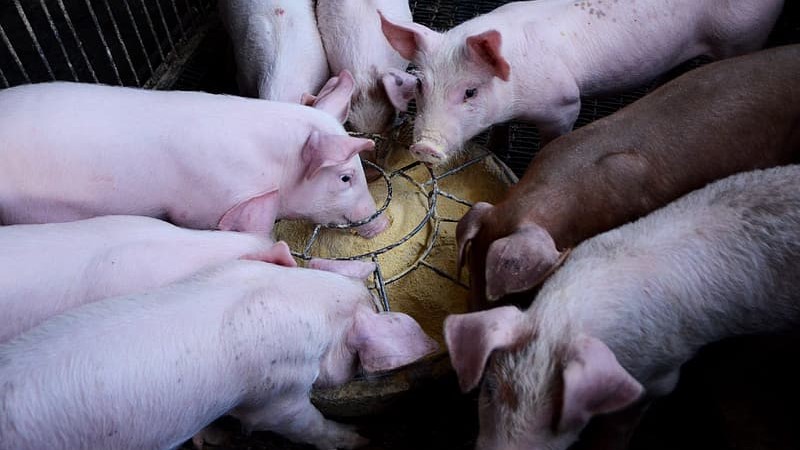Gut health is a complex field that we are still trying to decipher but there is increasing evidence supporting the use of probiotics in animal production to promote a healthier gut (Aluthge et al., 2019). The reality is, there is not a single correct way of promoting gut health. However, increasing pressure to limit the use of antibiotics and high levels of zinc and copper compels the industry to look for alternative ways to elicit optimal performance while maintaining a healthy herd. Probiotics can be effective if the proper dose of the appropriate strains is used to address an issue relevant to its mode of action.
Are there certain dietary or management practices more suitable for probiotic supplementation?

It has been reported that pigs fed fishmeal promoted an environment with enhanced susceptibility to diarrhea due to increased abundance of Escherichia and Shigella species (Cao et al, 2016). Pigs fed elevated levels of corn DDGS had altered colonic microbiota that increased susceptibility to colitis (Burrough et al., 2015) and swine dysentery (Wilberts et al., 2014). It can be hypothesized that probiotics that reduce gut pathogens, improve intestinal barrier function, and stimulate immune response may increase resistance to potential diseases caused by some dietary conventions. Amoxicillin treatment of day old pigs suppressed microbial diversity for up to 5 weeks after administration (Janczyk et al., 2007), presenting an opportunity for probiotics to reestablish and develop the normal pig microbiome post-prophylactic treatment of antibiotics. It is also possible that pigs fed all-vegetable diets may benefit from enhanced nutrient digestibility and fermentation capacity of particular strains of probiotics, especially during insufficient production of digestive enzymes in the nursery phases.
Is there an opportune time to deliver probiotics?
Early microbial colonization of the gut is critical to long-term health and development (Yeoman and White, 2014), suggesting the importance of probiotic supplementation in young animals. There is even increasing evidence that modulating the maternal microbiome during gestation via probiotic administration to the sow drives innate immunity development in neonates (Ma et al., 2018). It is possible that probiotics have greater odds of modulating the young animal’s microbiota than older and more mature pigs with already established microbial ecosystems. Young pigs need the most help they can get, which is also why nursery diets are the most complex of diets.

How do you measure improvement in gut health?
Direct measurements of gut health (e.g. oxidative status, cytokine production, intestinal barrier function) are difficult to obtain without proper equipment or sacrificing animals. Feed intake can be an indirect indicator of gut health since sick animals don’t eat due to the negative impact of gut inflammation on appetite (Willing et al., 2012). Fecal scoring to detect diarrhea incidence is rather subjective but is a quick and easy measurement that can be done by any personnel. If determining fecal scores, consider having two or more individuals making these observations and using the average to minimize subjectivity. Another indirect measurement is to monitor changes in mortality over time. You can also monitor the amount of veterinary interventions; diarrhea incidence is minimized in healthier pigs resulting in less medications. In most cases, it is not practical nor wise to run a challenge trial by introducing an enteric pathogen into your farm. Instead, consider less risky alternatives to challenge pigs such as curtailing sanitation protocols of a barn prior to fill, manipulating barn temperatures, or increasing stock density.
When evaluating alterations to the microbiota, specifically reduction in gut pathogens, is a bacterial count using a diagnostic test an appropriate metric?
Some diagnostics only indicate the presence of certain microorganisms, or lack thereof, but offer no information about specific strains or quantity. Most E. coli strains in the gut are non-pathogenic (Stromberg et al., 2018), so total E. coli count in the feces may not be an accurate representation of the inhibitory effect of a probiotic on pathogenic E. coli. In this instance, it is more appropriate to measure virulence factors expressed by these pathogens to indicate their presence. However, clinically healthy pigs can have elevated numbers of E. coli that express virulence genes making occurrence of these factors alone not a clear indication of disease (Schierack et al., 2006). In addition, microorganisms found in the digesta or feces may be different from those found in the intestinal mucosa that interact with the host immune system (Van den Abbeele et al., 2011).
Does a healthier gut always result in measureable improvement in growth performance?
No, probiotic supplementation to promote gut health is a harder sell for high performing herds because of the smaller magnitude of response, presumably because of already high health pigs, compared with low performing herds that have more room for improvement. Does that mean probiotics are optional in healthy production systems? Not necessarily, especially if you consider probiotics as “insurance” the same way as you would a vaccine at improving resistance to disease. Probiotics is by no means a replacement for a vaccine but is an additional tool in an effective herd health program.



